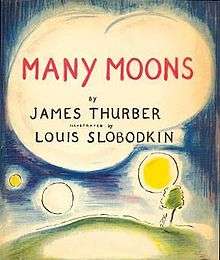Many Moons
 | |
| Author | James Thurber |
|---|---|
| Illustrator | Louis Slobodkin |
| Country | United States |
| Genre | Children's picture book |
| Publisher | Harcourt, Brace & Company |
Publication date | 1943 |
| Pages | 48 pp |
| ISBN | 0156569809 |
Many Moons is a children's picture book written by James Thurber and illustrated by Louis Slobodkin. It was published by Harcourt, Brace & Company in 1943 and won the Caldecott Medal in 1944.[1][2] Princess Lenore becomes ill, and only one thing will make her better: the moon. Unlike much of Thurber's other work, including The Secret Life of Walter Mitty and his fables, this story shows a crisis between males and females that ends happily for all.
Despite winning the Caldecott Medal with Slobodkin's original illustrations, a reprint in 1990 by Harcourt featured the text accompanied by new illustrations by Marc Simont.[3]
It was made into an opera by American composer, Celius Dougherty. It was also made into a play, adapted by Charlotte Chorpenning.
Plot
Princess Lenore suffers from "a surfeit of raspberry tarts" — eating too many sweets. She insists she is gravely ill, but if her father brings her the moon she'll be well again.
Her father, the king, asks the wisest men in his court how he can give his daughter the moon, and becomes outraged when they all claim that it is too large, too far away, and composed of unstable or dangerous substances.
Despairing, the king confides in his court jester. The jester then asks the princess what she thinks the moon is made of, how big it is, and how far away. According to the princess, the moon is as big as her thumbnail and made of gold. She says it's so close that he could climb a tree and pluck it from the sky. He promises to do just that, that very night.
Instead, the jester takes the princess's specifications to royal goldsmith, who creates a necklace with a moon-like pendant. It is presented to the princess and she becomes well again.
The next day, the King fears she'll see the moon in the sky and realize that the necklace is a forgery. He consults the wisest men in his court, who propose outrageous schemes to prevent her from seeing it in the sky.
Ultimately, the jester visits the princess, who is fondly gazing at the newly-risen moon. He asks her how the moon can be in two places, and she tells him the moon always grows back: like a child's tooth, a unicorn's horn, or flowers.
References
- ↑ American Library Association: Caldecott Medal Winners, 1938 - Present. URL accessed 27 May 2009.
- ↑ Many Moons by James Thurber, illustrated by Louis Slobodkin. Harcourt, Brace & Company, 1943.
- ↑ Many Moons by James Thurber, illustrated by Marc Simont. Harcourt, Brace & Company, 1990.
| Awards | ||
|---|---|---|
| Preceded by The Little House |
Caldecott Medal recipient 1944 |
Succeeded by Prayer for a Child |